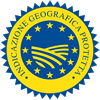Description
Mortadella di Prato PGI is a charcuterie product belonging to the category of cooked stuffed sausages, and is made from a mixture of pig meat, sea salt, garlic and alchermes.
Production Area
The production area of Mortadella di Prato PGI is within the entire territory of the Municipality of Prato, in the Province of Prato, and the municipalities of Agliana, Quarrata and Montale in the Province of Pistoia, in the Tuscany region.
Production Method
The first stage of processing consists of the selection of permitted pork cuts: shoulder, pork trim, lard, capocollo, cheek and bacon. The selected cuts, processed manually with the aid of a knife, are cut into cubes and left to rest for at least 24 hours in cold storage. The lean parts of the meat are ground in a meat grinder and then mixed with the cubes of lard, sea salt, garlic, pepper, spices, and finally the alchermes is mixed in. The mixture is stuffed into a natural or synthetic casing, which is then tied. This is followed by stewing: the product is hung in special rooms, with a gradual decrease in temperature over 1 and 3 days. Once this stage is completed, the product is cooked either in a steam oven or a boiler, until the centre of the product has reached a temperature of 70°C. Once cooked, the product is immediately rinsed and cooled in a refrigerated room for 24-48 hours. It is then dried 20 minutes before being packaged.
Appearance and Flavour
Mortadella di Prato PGI has a cylindrical or elliptic shape. On cutting, the consistency is firm and compact, soft on the palate. The meat is a brighter pink due to the colouring action of the alchermes, with white spots given to the cubes of fat. It has a penetrating spicy aroma, while there is a contrast between the hot and pungent notes of the spices, garlic and sea salt and the sweet, delicate flavour of the alchermes.
History
The first documents indicating Mortadella di Prato as originating in the Tuscan city date back to 1733, to the time of the beatification of Catherine of Ricci, when the nuns of the Dominican Monastery of Prato prepared a lunch for their guests and served it as a local speciality. Mortadella di Prato was invented due to the need to best use the parts of the meat discarded when making salamis, stuffing them into casings after being flavoured with spices and spirits, and cooking them in water. The product is of medieval origin and characterised by the original use of alchermes – a bright red liqueur once obtained from the cochineal (Coccus ilicis), the famous “dyer’s grain” – as a colouring and flavouring – and the large quantity of spices to help preserve the product.
Gastronomy
Like most cooked charcuterie products, Mortadella di Prato PGI should be eaten at room temperature and never heated. Mortadella di Prato PGI is ideal served with figs, preferably the Dottato variety (from Carmignano), and salt-free Pane Toscano PDO (Tuscan bread). Since the 1700s, Mortadella di Prato PGI has been used locally in traditional cuisine as an ingredient in many dishes, including Sedani alla Pratese (stuffed celery sticks).
Marketing
The product is marketed as Mortadella di Prato PGI. It is sold whole, in large pieces or in slices.
Distinctive Features
The use of alchermes as an ingredient in Mortadella di Prato PGI is a clear indicator of its origins. Alchermes is a bright red liqueur, once obtained exclusively from the cochineal, a parasitic insect that for centuries was dried and ground and used to dye fabrics, traditionally the city’s main economic activity.










